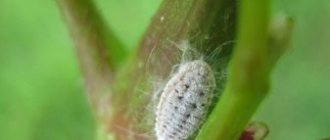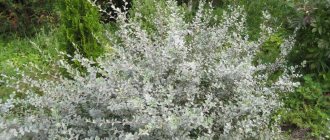Description of acanthus
Acanthus belongs to the Acanthaceae family. This is a perennial herbaceous plant. Distributed in the Mediterranean and in the tropics of Africa and Asia. The plant was given such names as: “mountain thistle”, “holly”, “bear’s paw”. There are approximately 50 species. Most are grown as ornamental.
The height of acanthus species varies from 40 centimeters to 2 meters. The leaves are dark green, glossy, large in size, curved, feathery in shape, divided into unequal lobes, and smooth at the edges.
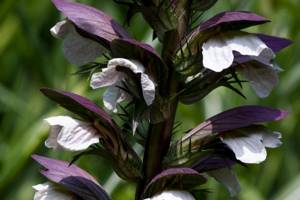
Acanthus buds are arranged in groups, forming the appearance of a spike. The flowers themselves are about 5 cm in diameter, mostly white, blue, red, pink, and occasionally burgundy. Pollination occurs with the help of insects.
Acanthus blooms for about 1 month from the second half of spring to the beginning of autumn. The period depends on the climatic weather in the growing region.
Acanthus bears fruit in pods. The seeds spread from them when the capsule suddenly opens. The seeds scatter to the sides at a distance of up to ten meters.
Most acanthus species are frost-resistant. The lifespan of the species is approximately 10 years.

Spectacular acanthus plant
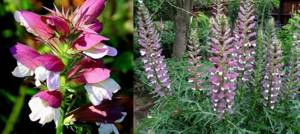
Depending on the variety, the appearance of the foliage changes. Still, there are some common characteristics. Usually deciduous plates:
- large (length 50-100 cm, width 30 cm);
- pinnately lobed with slight concavity;
- dissected or separated;
- pointed;
- covered with thorns;
- dark green color;
- planted on long petioles (up to 50 cm);
- form a voluminous rosette.
Such structural features of acanthus leaves became an inspiration for many artists of the ancient era. Craftsmen have created timeless masterpieces by incorporating original patterns of exquisite foliage.
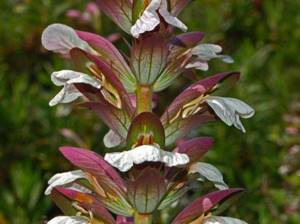
The formation of buds of the culture is observed in late spring or summer (June-July). The duration of the period is 3-4 weeks. Strong flower stalks reach 0.5-2 m in height (there are also shrub varieties).
Spike-shaped stems are covered with large flowers, the petals (5 cm) of which shimmer in shades of these tones:
- white;
- red;
- pink;
- purple.
The flowering process of acanthus is not entirely straightforward. One season the crop pleases with its lush racemose inflorescences, and in the second - only spectacular foliage without flower buds.
In addition, under the exquisite buds there are sophisticated dark purple bracts with pronounced thorns. This is precisely what can explain the origin of the Latin name of the acanthus plant “Acanthus”, which translated means “bract”. This distinctive feature gives a certain mystery to the bear's paws, since it seems that the young girls hid their luxurious heads behind their hoods.
Types of acanthus
Acanthus soft (blunt)
Growth in central Russia reaches about 50-70 cm; in warmer regions it can grow up to one and a half meters. Powerful roots, basal rosette formed by massive leaves. Leaves are up to 60 cm long, up to 15 cm wide. The stem is erect. The buds are white, with veins. The bushes have no thorns and form dense thickets. The plant blooms from July to August. Propagation by self-sowing. A very popular acanata species due to the luxurious shape of the leaves and bright flowers. Excellent for decorative plantings.
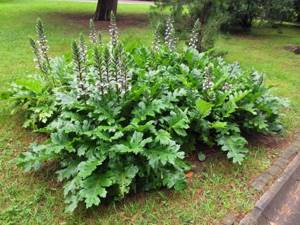
Acanthus spiny (acute)
The growth of the bush can be up to one and a half meters. Often found in the eastern regions of the Mediterranean. It is distinguished by the unusual coloring of its buds - the upper petals are purple and the lower petals are white. Flowering continues from July to August. Has thorns.
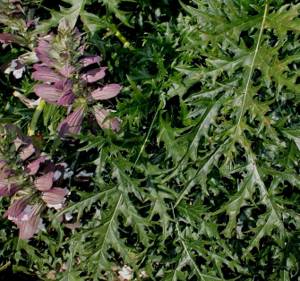
Dioscorides
It is extremely rare to see this species of acanata. Discovered relatively recently in Yerevan. Purple in color, long inflorescences.
Balkan acanthus (Hungarian, longifolia)
Frost-resistant species with late flowering.
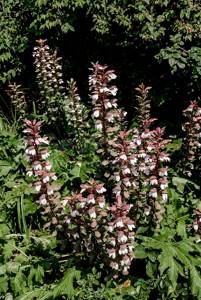
Anise leaf acanthus (mountain acanthus)
A species suitable for growing in pots and greenhouses. Heat-loving, prefers temperatures from +25 to +30 degrees and diffused sunlight. Evergreen shrub, up to two meters high. The leaves are smooth, glossy, dense, dissected, with thorns along the edges. This type of acanata has white-purple buds. In its natural environment it can be seen in India and on the warm shores of the Pacific Ocean.
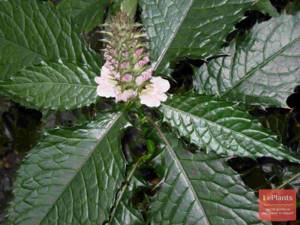
Description
The genus Acanthus (family Acanthus) includes 29 species of plants.
Most are herbaceous, but there are also subshrubs. In culture, these perennial plants occupy a worthy place among the decorative leafy representatives of the flora. Large leaf blades, reaching 100 cm in length, form an impressive rosette. The pinnately divided or dissected leaves are dark green. Even in ancient times, Acanthus inspired architects, artists, and jewelers. Stylized images of leaves were intricately woven into the ornaments of vessels and lamps, adorning capitals and even the crown of the English monarch Edward III, who unleashed the Hundred Years' War.
Acanthus flowers are not inferior in decorativeness to leaves. In summer, white, pink, and purple flowers with spiny bracts appear on a long erect peduncle.
Acanthus is grown in containers and in open ground. It grows beautifully as a tapeworm and in group plantings. Gets along well with Geranium, Allium, Cuff. The plant is suitable for cutting and creating dry bouquets.
Acanthus care
The plant is unpretentious. Suitable for growing by beginners and novice gardeners.
Acanthus is a heat-loving plant. Depending on the species, it prefers temperatures of about +23... +25 degrees in summer and about +18 degrees in winter.
For soil, the optimal ratio is 1:1:1:0.5 humus, peat, turf soil and sand. Good drainage and spraying of the bush twice a day is required, in winter once is enough, and on cold cloudy days spraying is not required. The plant does not tolerate wet and cold soil.

For good growth and lush flowering, attention should be paid to regular weeding, mulching and loosening the soil.
It is advisable not to replant acanthus unless necessary. If a transplant is required, it is carried out by transshipment. No more than once every three years.
The plant is quite aggressive towards its closest neighbors and can displace them. The area for acanthus should be limited by limiters recessed into the soil.
For active growth of green mass, you can prune the bushes. This is done after flowering.
Acanthus requires abundant and frequent watering. In winter, the water should be warm. It is necessary to ensure that the soil under the plant is not dry for a long time. Acanthus is able to withstand drought for a short period.
You can feed the bushes from spring to autumn. Once every two weeks with any universal complex.
Acanthus loves diffused and warm light. It is advisable to choose a place on the site without drafts. When planting, you need to take into account the size of the plant - spreading acanthus occupies a fairly large area.
Growing acanthus
Growing conditions . Acanthus prefer sunny, open areas. In the southern regions, planting in partial shade is possible. Spreading acanthus bushes take up a lot of space, which needs to be taken into account when planting.
Soil and watering . Acanthus prefer well-drained soils, rich in humus, with neutral or reduced acidity. Drainage is especially important in winter, because... in wet, cold soil the plant may die. Watering is moderate, as needed. The plant can tolerate short-term drought.
Care . The life expectancy of acanthus, if care recommendations are followed, is over 10 years. Growing does not cause any great difficulties. In particularly cold or snowless winters, the plantings are covered with spruce branches.
Possible acanthus problems
You need to monitor the air temperature very carefully. At temperatures below +16 degrees, the leaves of the bushes fall off. Lack of moisture is also dangerous for the plant. When spraying, you should be careful, because... this can lead to loss of decorativeness. The plant is susceptible to sunburn and overheating, and brown and white spots form on the leaves. Acanthus leaves react very sharply to excessive watering. If the soil is heavy, the green mass will wither.
For non-frost-resistant acanthus species, pruning is carried out. Everything is cut off from the surface of the earth at once. Covering material is placed on top.

Planting and propagation
Since this herbaceous plant does not tolerate transplantation, its habitat must be decided in advance. It is best to choose a warm, sunny area, without strong winds and with obligatory underground restrictions for the roots. On the above-ground part, it is necessary to provide the bush with free space, since, having matured, it will become quite spreading.
Acanthus has no special requirements for the soil; it is enough that it is light and moisture-permeable. Slightly alkaline and neutral soils are welcome, but acidic soils are not recommended.
Acanthus has several methods of reproduction:
- Seed. It works well only if the acanthus seeds are perfectly fresh. Their hard shell requires a procedure called scarification, which involves breaking the integrity of the surface. After this, it is customary to soak them until the sprout pecks, possibly in a biostimulator. Next, the seeds are placed in cups with nutrient soil, covered with film and placed in a dark place for a week. After this time, you can see the first shoots of acanthus; in this case, the cups are moved closer to the light and the film is gradually removed, making a small allowance for adaptation to the sun. Seedlings are planted in the ground at the end of May, when the danger of frost has already passed.
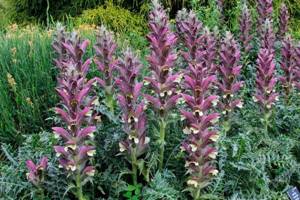
- Cuttings. The herbaceous plant is cut into 15-20 cm pieces, with the obligatory cut of the lower part under the bud, the lower leaves are removed and placed in damp sand, covered on top with a plastic bottle without a bottom. At a temperature of 20-25 degrees, rooting will occur quite quickly.
- Rhizome cuttings. Acanthus has a very powerful stem, cuttings of which give excellent propagation results. It is enough to cut it in early spring into thick, fleshy fragments of 5-8 cm, always with an apical bud, and plant it in a permanent place.
- Dividing the bush. In the spring, after the leaves have grown, you can divide the acanthus bush into several parts.
Such a large herbaceous plant will look great in the middle of the lawn or will be an excellent backdrop for short gardeners. Acanthus makes a good screen for unsightly fences, as well as very beautiful bouquets. Its flowers are even used to make dry compositions, as they hold their shape well and do not fade for a long time.
Would you like to plant acanthus in your garden?
Diseases and pests of acanthus
Various insect pests do not attack the plant. Acanthus is also quite resistant to diseases. If the plant's care regimen is violated, powdery mildew may appear. In case of powdery mildew, the affected leaves should be immediately removed and the bush should be treated with fungicides. If overwatered, the plant is threatened by slugs, which spoil the decorative appearance of the flower.
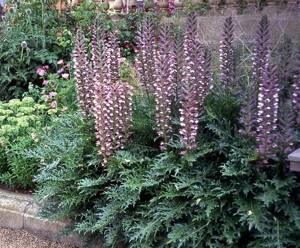
Possible problems
When growing a particular plant, a gardener is bound to encounter certain difficulties for which he must be prepared in advance. As for acanthus spiny, from time to time the owners of this culture are overtaken by the following problems:
- The appearance of whitish spots on the foliage, which indicates an excess of heat.
- The appearance of wilting leaves due to overdrying or waterlogging of the soil.
- The appearance of dark spots on the leaves due to lack of nutrients.
- Wilting due to unsuitable temperature conditions.
- The appearance of plaque on the leaves (indicates powdery mildew infection). The problem can be solved with the help of fungicides that are used to treat the crop.
In general, different situations can arise in the process of growing acanthus. The main thing is to be prepared for anything and take timely measures. In folk medicine, acanthus is used to stimulate appetite. It is also a good laxative and can have an anti-inflammatory effect. But the main task of acanthus prickly is to decorate the place where it grows and give people aesthetic pleasure.
Author: Kazimir Julia
Acanthus propagation
Acanthus is propagated by seeds, dividing the bush or cuttings.
Propagation of acanthus by seeds
Only fresh seeds are used. Before sowing, a scarification method should be performed. Then on the third day the seeds are immersed in warm water. It is necessary to change the water every 3-4 hours to maintain its temperature. Before sowing, growth stimulants are used. In the planting container, the seeds are deepened 1 cm into loose soil. Cover with transparent film or glass and place the container in a warm place. The shelter is removed as soon as the first shoots appear, on the 7-10th day. The sprouts are transplanted into separate pots and provided with moderate watering. When planting in the ground, bushes should be planted at a distance of 60-80 cm from each other. Flowering occurs in 2-3 years.
Reproduction

Seeds
Seeds are sown in early March; for successful germination it is better not to neglect pre-treatment. Place them in a shallow bowl and cover with clean water at room temperature. One or two days are enough to soften the seed coat and absorb the required amount of moisture. Sow each seed in loose soil to a depth of 1 cm. You can sprinkle it with vermiculite. A sprayer will help maintain moderate humidity. The first shoots may appear in the third or fourth week. The seeds will germinate unevenly. The formation of 2-3 leaves serves as a signal to transplant into separate pots with drainage. Within a month after this, each bush can be planted in open ground in a place of permanent cultivation.
Cuttings
It is difficult to divide an adult bush without damaging the root system. Root cuttings can be used to obtain young specimens. In the spring you need to dig up the soil, cut off that part of the root on which leaf buds are visible, let there be about 2-3 growth points on each fragment. They can quickly take root in compost mixed with sand.
Pests, diseases of the bear's paw plant

Acanthus flower growing
Acanthus is resistant to diseases and pests. But with poor care it can be damaged by spider mites, scale insects, and aphids. Sometimes it is affected by powdery mildew.
Special requirements . When growing on the site, take into account that acanthus bushes require a lot of space, they have well-developed rhizomes, and over time they crowd out surrounding plants. Looks elegant against the backdrop of hedges and large trees. Dried inflorescences and leaves should be periodically removed. Young plants are covered with spruce branches for the winter.
In snowless winters, mature bushes also require shelter. Does not tolerate drafts or overcooling of the root system. When working with it, protect your hands and exposed parts of the body from injections; they are not poisonous and painful. For this reason, exclude children from playing near the holly.
Invasiveness and environmental impact
Bearbreeches are successful invaders that can escape from gardens and are capable of colonizing disturbed areas as well as natural forests. This species grows in the forest understory and, once established, is capable of quickly replacing the natural vegetation of that forest layer. Soft acanthus grows to form dense soil cover and thickets that prevent native plants from germinating and establishing seedlings.
Acanthus softis is an agricultural pest in several states of Australia. Acanthus mollis is difficult to eradicate because its dry capsules explode, scattering seeds over a large area, and its roots grow back quickly.
Growing acanthus in a summer cottage
This garden plant is also called "bear's paw". This is due to the fact that acanthus leaves are very similar to a bear’s paw print.
It may also be called holly, mountain thistle, and claw. All types of flowers are strong and hardy.
The foliage is very diverse, as it can be smooth or with thorns without needles, it can be pinnately dissected and cut into unequal parts.
The flowers are collected in spike-shaped inflorescences. They come in white, purple and lilac.
The petals reach a size of 5 cm. And the height of the plant itself can be from 40 cm to 2 m, while the roots are very powerful.
Did you know? In ancient times, this flower was a symbol of masculinity and victory over difficulties. The plant was believed to grow on the graves of heroic warriors. However, in Christian symbolism, acanthus leaves are associated with the suffering and rebellion of the sinner.
Varieties of acanthus
Today, more than 30 species of this ornamental plant are known. The most popular of them:
- Acanthus anise leaf. Grows in mangrove thickets. The foliage is dark green in color, satiny smooth, 8-10 cm wide and 20-30 cm long. The leaves have a pinnately dissected shape. Flowers of white-lilac shades with large cylindrical inflorescences. Distributed on the coasts of the Pacific and Indian oceans. Well suited for growing both in pots and greenhouses. The roots are aerial and spread in different directions, giving the plant a special charm.
- Mountain. This species is native to West Africa. It is an evergreen shrub characterized by many aerial roots. The leaves are pinnately shaped, olive green in color, and can reach a length of 30 cm, with wavy and slightly spiky edges. White-purple flowers form inflorescences up to 25 cm in length. The diameter of one flower is about 5 cm. Mountain acanthus is an ornamental plant that takes root well in potted conditions.
- Acute (prickly) is the most popular perennial in flower beds and gardens. It received its name for its leaves and bracts, on which there are prickly needles. The flowers are very beautiful, formed in two shades: the upper lobes are purple and the lower lobes are white. The height of acanthus acute can reach 150 cm. This species blooms from July to September.
- Soft (dull). In its homeland, in the Mediterranean, the plant can grow up to 190 cm, in our area it is slightly lower - about 75 cm. Its stems are straight, and the foliage is very massive, about 30-60 cm long, up to 15 cm wide. The bracts are dark -pink or purple. Soft acanthus also has varieties that differ in the size of the foliage and the presence of thorns on it.
- Balkan (Hungarian, longifolia). It is very similar to acanthus obtuse, the differences are only in the deep cuts in the basal foliage of the Balkan acanthus, the bases of which are noticeably narrowed. This species is the most resistant to cold.
- Dioscorides. The species was found quite recently on the slope of Mount Adis, near Yerevan. The species is rare and extremely beautiful. The inflorescences are long, the buds are purple.
Conditions for growing bear claws
To grow such a plant in your summer cottage, you should carefully study the conditions that it needs for good development.
Climatic conditions
Acanthus is a heat-loving plant. In summer, the optimal temperature range for it is 18-25 °C, in winter - 16-18 °C.
In this regard, summer residents grow some types of “bear paw” in containers, taking them out into the garden in the summer and taking them indoors for the winter.
You can also decorate your site with such perennial plants as: fuchsia, feather grass, physostegia, heuchera, mountain weed, cornflower, loosestrife, catnip. It also requires good lighting, so the area where this plant grows must be open to sunlight.
Soil type
Acanthus is not a particularly capricious plant, but still needs suitable soil. It is advisable to plant it in fertile soil, light, neutral or slightly alkaline.
It is also very important to provide the plant with good drainage so that moisture and air can easily reach the root system.
Did you know? Animals that eat grass practically do not touch acanthus because they do not find its prickly, tough foliage attractive.
Planting acanthus
To grow a beautiful and powerful bush, you must adhere to the basic rules of agricultural technology. Before planting, seeds need to be scarified and soaked for 2-3 days in warm water.
At the same time, the water needs to be changed every 6-8 hours so that it does not heat up even more. After 10 days, the seeds, which should be kept in a dark room all this time, will have time to germinate and can be planted in the soil. It's better to do this in March.
The substrate for planting is prepared from sand and peat. It is important to maintain a distance between plants of at least 70-80 cm, since acanthus grows very quickly and powerfully.
Watering
Abundant watering should be observed from spring to autumn. In this case, it is impossible to allow waterlogging, as this can cause the root system of the plant to begin to rot, and snails may also appear.
In winter, moisture can be reduced, but care must be taken to ensure that the root soil does not dry out.
Important! Additionally, you can spray acanthus from a spray bottle from time to time. This should be done extremely carefully so that water does not get on the inflorescences. You can spray 2 times a day in summer, and 1 time a day in winter.
Fertilizer
It is recommended to apply fertilizers from March to September. It will be enough to carry out this procedure once every two weeks. Fertilizers need to be selected that contain organic compounds.
You can purchase a liquid three-component product at a specialty store that is used for flowering plants.
Organic fertilizers that are perfect for acanthus: potassium humate, vermicompost, yeast, nettle solution, onion peels, charcoal, potassium salt, manure, tobacco dust, feces.
Reproduction by cuttings
Acanthus cuttings are planted in a container filled with wet sand at an air temperature of +20 to +23C°. If the top of the plant begins to grow, this is a sign that the roots have begun to grow. From this point on, you need to wait a few weeks and then plant it in the ground.
As soon as the root system develops, the seedlings are planted in the place intended for them. They usually bloom in the third year after planting.
Dividing the bush
You don’t have to completely dig the bush out of the ground, but divide it with a shovel, sticking it at a right angle between the fused roots. Then you need to carefully separate and pull out the cuttings, transferring them to a previously prepared place for planting. The distance between such plants should be 60−70 cm.
Morphological description, structure and flowers of roses
Diseases and pests
Acanthus is resistant to diseases and pests, but if not properly cared for it can be damaged by spider mites, aphids, scale insects, and sometimes powdery mildew. Due to the fact that this plant has a very voluminous root system, it needs to be given a sufficient amount of space on the site, otherwise after some time the acanthus will happily crowd out all other plants.
When caring for it, it is necessary to remove dry leaves and flowers from time to time, and very young individuals should overwinter under a cover of spruce branches. If the winter turns out to be little snow, then even adult plants should be covered.
Description of acanthus flowers and their photos
A tall evergreen perennial with powerful roots and weakly branching stems, reaches 180 cm in height and 60 cm in width.
Acanthus leaves are dark green, shiny, short-petioled, up to 30 cm long.
The plate is wavy, spinous, lanceolate or elongated-lanceolate in outline, pinnately lobed or dissected into unequal pointed triangular lobes, the edge is notched.
As can be seen in the photo, acanthus has bisexual, zygomorphic flowers up to 5 cm long.
Collected in an inflorescence in the form of a spike up to 25 cm high. The calyx and bract are spiked, the corolla is two-lipped, pale pink or purple. The fruit is dry - a two-locular pod-shaped capsule.
Developmental biology of the acanthus plant
Reproduction is by seed and vegetative - by root suckers.
The flowering period of mountain acanthus occurs in summer - early autumn. The plant is pollinated by insects, usually bees. The ripe capsule is sharply opened by two flaps, and the seeds, like throwing discs, are forcefully thrown out thanks to jaculators - springy outgrowths on the inside of the flaps. Young acanthus sometimes grow at a distance of tens of meters from the mother plant.
Alternate names "mountain thistle" and "bear's paw" were given to mountain acanthus due to its spiny leaves. The name of the genus translated from Greek sounds no less threatening - “spiked”
- https://agronomu.com/bok/3617-vyraschivaem-akant-na-dachnom-uchastke.html
- https://nasotke.pro/tsvety/vyrashhivanie-rasteniya-akant
- https://www.flowerbank.ru/?p=4001
Did the article help? Rate it Loading...
Source: https://ogorod.life/derevya-rasteniya-i-travy/vyrashhivaem-akant-na-dachnom-uchastke.html
Soft acanthus (Acanthus mollis) - description, cultivation, photo
Name:
came to us from the ancient Greek language and is associated with points on leaves and bracts.
Photo by EDSR.
St. Petersburg
This Mediterranean plant does not have a Russian name as such, but in the horticultural literature of the 19th century you can find it under the name “bear's paw”, which is a literal translation from pharmaceutical Latin - Branca ursina. Under this name in the Middle Ages and later the leaves and roots of a. soft as an enveloping and softening agent were used for diarrhea, cough, burns. Sometimes you come across the “bear claws” and “holly” variants.
The word “acanthus” refers to a sculptural or relief decoration in the form of a stylized plant – acanthus. It has been in the culture for a long time. Acanthus spinosus, with narrow sharp lobes giving a sharp shadow, was preferred in images in Dr. Greece. Wide, blunt, somewhat concave leaves of soft acanthus (acanthus mollis), which produces rich chiaroscuro, were often used in the buildings of Dr. Rome. From ancient architecture, the passion for acanthus was adopted by Gothic architecture, and in ancient Gothic buildings its leaves are found on the capitals of columns, in the ornamentation of cornices and friezes.
Description:
The genus includes about 20 species of large perennials, mainly of Mediterranean origin. The pinnately incised or dissected leaves of these plants form powerful basal rosettes. Flowers with spiny-toothed bracts are collected in large, dense, cylindrical inflorescences.
| Acanthus acute, or barbed – Acanthus spinosus Homeland - eastern regions of the Mediterranean. Zone according to Western catalogs: 6(7)-10. Most often found in gardens. Herbaceous perennial. The upper helmet-shaped part of its flowers is lilac, and the lower “lip” is white. The leaves and bracts are spiny. Height is about 85-150 cm. Blooms in July-August. And at a. prickly there is a particularly prickly form, sometimes it is distinguished as a separate species - a. most spiny (A spinosissimus) with strong white points along all leaf teeth. Photo by Kirill Tkachenko |
| Acanthus soft, or blunt – Acanthus mollis Homeland - South-Western part of Europe. Zone according to Western catalogs: 6(7)-10. A perennial with very attractive large leaves. In its homeland, the height of this plant reaches 1.5 m; here, as a rule, it is 50-70 cm. It forms large groups. Stems are erect. The corolla is up to 5 cm, whitish with purple veins, and the bracts are purple or pink. The basal leaves are non-thorny, up to 30-60 cm long and 5-15 cm wide. Variety var. latifolius has wider leaves. There are varieties, for example, “Bear's Breeches“. Photo provided by L.V. Presnyakova |
Acanthus longifolius
Photo by Kirill Tkachenko
acanthus of Dioscorides is practically never found in culture
(Acanthus dioscoridis) with entire leaves and large purple flowers collected in a long pyramidal inflorescence. Three small populations of this species were found near Yerevan at the northern foot of the city of Adis.
Acanthus Balkanis
(A balcanicus) (aka A. Hungarian - A hungaricus, aka A. longifolius - A longifolius) is generally similar to the soft one, but with more deeply incised basal leaves.
Balkan differs from prickly by the leaf lobes tapering towards the base and less sharpness. Read more about growing acanthus longifolia in Kiev
.
Location:
In nature, acanthuses are plants of shady habitats: forests and shrubs on rocky slopes, but in our northern gardens they need to be given a sunny place. Requires a lot of space.
The soil:
any well-drained fertile garden soil, preferably light, neutral or slightly alkaline, preferably light loam.
Photo of Andrey Milyaev
, Voronezh
Care:
doesn't like transfers. Despite their origin, these plants are quite winter-hardy in the Moscow region, as well. Balkan, the most frost-resistant, has been living for about 10 years without shelter for the winter with T. Konovalova. True, after a particularly harsh winter, the plants may not bloom.
Reproduction:
seeds and vegetatively. Sow in March under glass. Before planting, the seeds are scarified and soaked in warm water for three days. The water is changed every 8 hours to keep it warm. Seeds germinate in the dark within 10 days. In hot years, even here their seeds ripen. To improve this process, you can remove the upper part of the inflorescence, where the flowers bloom later than the lower ones. Large seeds are not lost even when sown directly in the ridges in the spring. Seedlings bloom in about the third year. Acanthus grow well and divide easily in spring or late summer. The distance between plants is 70-80 cm.
Usage:
Acanthus form dense, beautiful clumps. Their sculpted leaves and inflorescences will decorate flower beds, large hills with large stones and will look great when planted in separate groups on lawns. The inflorescences are suitable for cutting, and also retain their shape well when air-dried in a vase or upside down and then last a long time in dry bouquets.
Description and varieties
Acanthus comes from a genus of perennial herbaceous plants of the subshrub type. This member of the Acanthaceae family comes from the African and Asian subtropics. That's where it has such a powerful root system and huge glossy leaves. Their texture and carved pattern can vary depending on the variety: simple and pinnately divided, curved, asymmetrically incised or with wide lobes, with smooth edges or prickly. Such diversity even contributed to the emergence of a special pattern called acanthus in architectural and artistic crafts.
The acanthus flower has a complex structure of a spike-shaped inflorescence, which has four sides. Colors can be completely different: from white to purple. The flowering process lasts almost a month, but depending on the variety it can occur from May to September.
Attention! The beauty and intensity of acanthus flowering are directly dependent on weather and climatic conditions, as well as on care and watering regime.




